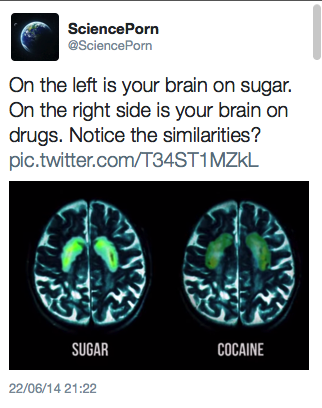“Seeing is believing.”
“Is it? What about touching?”
Little Red Riding Hoods Father and Little Red Riding Hood in “The Company of Wolves”
SciencePorn (yup, such a Twitter account exists, and it is what you think it is) had an interesting tweet online:

I think this is a beautiful example of a case where you can easily go wrong with confidence — because it is just so obvious and plausible. And it might well be the case. But there’s (at least) another explanation. These areas can light up whenever a person … puts something into his/her body. You only see the similarities here. But similar to Tufte’s comment about reasoning about causality:
“in reasoning about causality, variations in the cause must be explicitly and measurably linked to variations in the effect”.
Tufte (1997)
you need to see images of other cases where these areas do not light up. These two pictures, while certainly seeming to point out the similarities between sugar and a highly effective drug, do not proof anything. Not unless you show that these areas stay dark when the person eats, I don’t know, perhaps yoghurt.
And if you do, does it show that sugar is as pleasurable/addictive as cocaine? I don’t know. I’m not a neuro-scientist. That’s not the issue here, the argument itself is. Because I know a bit about making an argument and this ain’t it.
So if someone shows you “proof” that two things lead to the same results, ask for evidence that different things do not lead to similar results. It might just be a default. And with images, even ones as pretty and plausible as this one, the question is always: What is not shown. Of the image, or of cases/other groups that are excluded. That happens a lot, especially when it comes to “plausible” topics where the public already has an “ideological correct” opinion that just needs to be driven home. Reality, of course, doesn’t care much for ideology. Whether you do, esp. when reality might be more differentiated, is up to you.
P.S.: Where exactly was this study done? I mean, did they really give some of the participants cocaine? And yup, that’s another good question to ask. Google image search hints to the image being used in the documentary “Fed Up” by Stephanie Soechtig. Hmm, I would probably have a look at it to get further clues. Nah, it’s almost 2am, time to sleep.
Literature:
Tufte, E. R. (1997). Visual and Statistical Thinking: Displays of Evidence for Making Decisions. Cheshire, CT: Graphics Press.
But highly relevant of course is what the control conditions were in the studies? It is highly likely that the studies controlled for some neutral stimulus. Brain activation is always the result of a deduction of two conditions. Never simply the activation as a result of 1 type of stimulus.
That’s a good point, I didn’t think about it. And sure, it would have to be the same control condition when it comes to less presumably-druggy kinds of stimuli. And these are all questions which are not obvious when images are send around on Twitter.